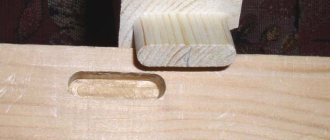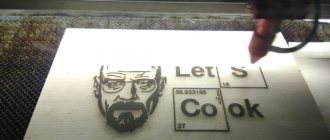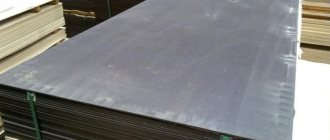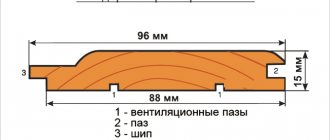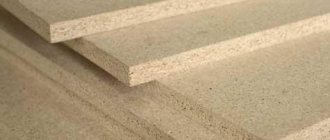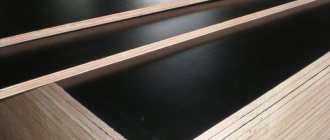If you quite often make various wooden products for your home, then sooner or later you will acquire a hand router. Of course, some types of manual milling work can be done using an electric drill, which is available in almost every home workshop.
You can read about different cutters for drills here.
But the main difference between a router and a drill, besides the presence of an adjustable support platform, is its high speed (from 10,000 to 30,000 rpm), which even the most high-speed drill cannot boast of. But this is precisely what determines the level of quality of the result obtained. But, you will also need the right equipment - cutters, and a great variety of them are produced for this tool.
Helping you understand their varieties and types is the goal of this article.
What types of cutters are there for a hand router?
To get started, we suggest watching the video:
And according to the design of wood cutters there are:
- monolithic;
- compound;
- mounted.
Monolithic cutters do not need a detailed description.
But compound and mounted ones are often confused. Composite cutters are cutters in which two or more types of cutters are combined into a single unit on one shank. In them you can change the order of the cutters and the distance between them, insert intermediate bushings or bearings.
And the attachment ones have a large hole in the center and are mounted on the shaft of the milling machine.
And according to the nature and place of application, cutters for hand routers are:
- end;
- edge;
- grooved;
- copying.
8
This video will help you better understand their diversity and purpose:
Let's look at it in order.
What is a manual milling machine
Small wooden parts are processed at home using a manual milling machine. Let's look at what types of cutter sets there are and what they are used for.
Main Application:
- For installing doors
- For mounting window frames (frame cutters)
- When turning small bars and planks
- When creating holes for installing door and window locks
The router is used only for spot work on small wooden areas.
The power of the tool is:
- Easy
The lightweight model has a power of up to 750 W. Suitable for small jobs at home.
- Average
With a power of 750–900 W, the model is in demand. This is an indispensable assistant during the installation of furniture frames and the creation of shaped parts from wooden blocks.
- Heavy
The heavy model is used to make professional products. It has a power of 900–1200 W.
End mills
Their main feature is the presence of cutting edges at the end of the working part.
This does not mean that they only work with axial loads. They can also have side edges that allow you to move the cutter in the plane of the router's support pad, making various grooves and cuts in the material. They may have a different number of cutting edges, and, accordingly, different cleanliness of material processing.
End mills are most often monolithic, but there are also composite ones. A striking example of this can be core cutters, more often used with a drill.
Types of blades
The blades can be positioned on the cutter at certain angles, in a vertical position or in a spiral. With straight blades on the workpiece, you will only be able to cut down small sections of wood. At the same time, the option located at a certain angle allows you to make cuts, making it unlikely that chips will appear in the work area.
If we talk about the characteristics of the blades, as well as the materials from which they are made, then we can distinguish 2 options:
- H.M. They cut quickly. Ideal for processing softwood and aluminum.
- H.S.S. Carbide blades. Since such cutting edges have a better temperature coefficient, and in general all their properties are better, they are usually used for processing hard materials. True, their price is higher than that of HM.
Edge cutters for wood
This is the most widely represented range of this tool, due to the most frequent use of hand routers specifically for forming various edges on wooden products.
Even in large sets of cutters, which it is preferable for a home craftsman to have rather than buying a large number of cutters randomly, the main part is edge cutters.
And their classification is much wider than that of other types of cutters. They are:
- profile - giving the processed edge an intricate curly shape;
- molded - rounding the edge with a convex shape to a quarter of a circle;
- conical – chamfering at an angle (more often it is at 45°);
- disk - for grooves in the edge;
- folded - selecting a quarter in the edge;
- fillet - making grooves in the edge on a quarter of a circle;
- figireous - for forming the edges of panels.
As a rule, all edge cutters for wood have a thrust bearing that limits the penetration of the tool into solid wood. The depth of the cutter's reach is regulated by the position of the support platform of the router itself.
And the methods of working with such cutters are the same. If the cutter removes a large mass of wood at once, then it is better to carry out the processing in several passes, gradually deepening it into the wood until the thrust bearing starts working. You can watch the video:
Classification and purpose
The functions that a cutter can perform are determined by the diameter and shape of the blade.
Among them there are multifunctional samples capable of performing a lot of different operations.
Specialized types are also used, intended for only one single function.
According to the type of processing, there are the following types of cutters:
- grooved;
- edge;
- end;
- copying;
- end;
- disk;
- shaped, etc.
The specifics and techniques for working with cutters of different categories are fundamentally different from each other. To work with them, you need experience, the ability to use components or make auxiliary devices yourself. Let's look at them in order.
Functions performed
End mills, which are among the most common tools used for manual milling work.
Don't miss: Vertical milling machines: device, description, video
Wood cutters are capable of performing various operations:
- Manufacturing of grooves, sockets, recesses of various shapes.
- Copying according to a pre-prepared template.
- Giving the edge a specific profile.
- Creating a toothed profile for longitudinal gluing, forming a shaped surface for panels, etc.
Shank diameter
Milling cutters are distinguished by shank diameter.
The most common options include cutters with a shank of 6, 8 and 12 mm. Imported models are pegged to the inch and most often have a quarter or half inch diameter.
It is noteworthy that they do not fit together in any way; it will not be possible to install an inch shank into a millimeter collet. Given the high cutting speeds, the slightest runout can cause injury or damage to parts. Therefore, it is important to use only elements that match each other.
There are also cutters with a non-standard shank diameter, for example, 7 mm. They are less common, but when purchasing, you should check the parameters of the cutting tool.
A collet is not a cartridge; it cannot be compressed over a wide range. High clamping and holding strength of the shank requires the use of appropriately sized tooling.
Grooved
Groove cutters are a broad group.
They are designed for making recesses of a given shape and size.
They are often used for inserting locks and hinges.
The working surfaces are the side and end sides.
Several types of slot cutters are used:
- straight. Used to produce a groove with a flat bottom;
- fillets. They form a groove with a round bottom suitable for laying pipes of the appropriate diameter;
- V-shaped. They form a groove with a bottom converging at a water angle;
- structural. These are T-shaped or dovetail cutters. They are used in the manufacture of high-strength joints - furniture boxes, boxes, etc.;
- shaped. Used for applying frames on panels, ornaments or decorative elements on furniture or carpentry parts.
A common feature of slot cutters is the absence of a thrust bearing on the end of the tool. They are available in several sizes, with different diameters of the working part. To work with them, you need to have additional devices - templates, stops, a compass rod, etc.
Edge
They differ from other types by the presence of a bearing in the lower (end) part.
The working surface is only lateral; it is impossible to create a recess in plastic with such a cutter.
The following types of edge cutters are distinguished:
- straight. Designed to create a smooth, flat edge of a part;
- moulding. The upper part of the edge is processed, rounded or given a shaped profile;
- rebated. Used to create quarters. The diameters of the bearing and the working part differ by a certain amount, which determines the size of the step. They are convenient because they do not require creating and installing a template. Some samples are sold complete with a set of bearings, which can be changed to achieve different quarter sizes;
- conical Designed for chamfering, preparing parts for gluing at an angle and other needs;
- fillets. Form a semicircular groove or chamfer on the edge of a part;
- curly (shaped, multi-profile). They form a certain relief that occupies the entire area or only part of the edge;
- half-rod (half-roller). A figure is created on the edge, which is the longitudinal half of a cylindrical rod. If you pass a cutter from the opposite side along a workpiece whose thickness is equal to the diameter of the roller, you can get a round rod;
- combined. This is a fairly large group of tools, representing a set of several cutting elements on one shank. They can be intended for the manufacture of frames, panels (figare), grooves with tenons. Special toothed sets are widely used for joining wood in both longitudinal and transverse directions.
Edge cutters are the most numerous group of cutting tools. They are used primarily to create a decorative effect, although there are examples for purely technological purposes.
Attention! To work with shaped or combined cutters, especially with a long working part, you need a high-power machine (at least 1600 W).
End
End mills are a group of tools, the working part of which is located on the end and side parts.
The previously discussed groove cutters are a type of end mill.
There are conical, spiral, and burrs that allow you to perform decorative work or create grooves of complex shapes.
Apart from standard groove samples, end mills are used quite rarely, since they are designed for specific operations with hard materials, and therefore are not of particular interest to home craftsmen.
Copying
Copy cutters belong to the family of edge tools.
They consist of a support bearing and a cutting part of the same diameter.
To work, you need a template that is attached with clamps or double-sided tape to the surface of the workpiece. The offset of the cutter is adjusted in such a way that the bearing rolls along the template, and the working part cuts off all excess and leaves an edge with the desired outline.
Sometimes ordinary groove cutters are used as copying cutters, the diameter of the working part of which is equal to the diameter of the shank. The smooth part slides along the template, and the working part removes excess material. For such work, it is recommended to use metal templates, since wood does not withstand the friction of the shank and burns when delayed or under strong pressure.
Groove cutters for wood
Their main purpose is to form grooves, but most often they are used for carving wood using a hand router.
And there are quite a lot of varieties:
- spiral - the same type as most end mills with a more formed external helical cutting edge, reminiscent of a drill;
- fillet – making semicircular grooves;
- conical - often they are used for carving on a plane;
- T-shaped;
- dovetail type;
- shaped;
- combined - used for gluing large wooden panels.
Groove cutters that work on the surface of wooden products are most often monolithic, but they also come with carbide cutting edges.
Copy cutters
This is the smallest subgroup of cutters for a hand router. The main difference between such cutters is the overall dimensions, the number of cutting edges and the location of the thrust bearings or thrust surfaces: above, below or on both sides of the cutting part.
They are the ones that come into contact with the template, according to which the milling shape of the workpiece is copied. The principle of their operation will become clearer after watching a short video:
Functional sets of cutters and more
Quite often, manufacturers create sets of cutters designed to perform the same type of work, with a completed cycle of processing wooden products or producing the same type of joints.
This set of 2 cutters not only forms the inner edge of the frame product, but also makes the groove part of the corner joint in this frame. It is easy to understand that it can also be used to join boards into panels.
This set is used for making thin wooden window frames and other similar works.
But each of its cutters, of course, can act as an independent tool for performing a number of other types of wood processing.
The composite cutter shown in the following photo, depending on the sequence of assembly of its constituent elements, is used to form both edges of the wooden lining.
And by using a metal sleeve of the appropriate size instead of one of its components, this cutter can become either a moulder or a disk edge cutter.
Of course, as with other hand-held power tools, you can greatly expand the capabilities of a hand router by building a table for it.
By attaching movable stops to it, you will turn the hand tool into something like a milling machine. And with its help and a set of cutters, like the ones mentioned above, you can do very interesting things:
We recommend other articles on the topic
How to use a laser level, types of laser levels
Gun for polyurethane foam - the right choice, disassembly and repair
Construction rule - how to choose and use tools correctly
Rotary hammer, hand drill - in what cases should it be used?
⑨ AZKOR Aluminum HRC50
Rating: 4.9 Price: from 122.81 rub.
up to
812.34 rub.
Go to the store The tungsten steel milling cutter from the AZZKOR brand has exceptional durability and is designed for professional processing of wood products. The cutter tip contains 3 blades. The diameter of the nozzle is from 1 to 12 mm.
Advantages:
- titanium-aluminum coating.
Buy on AliExpress.com
